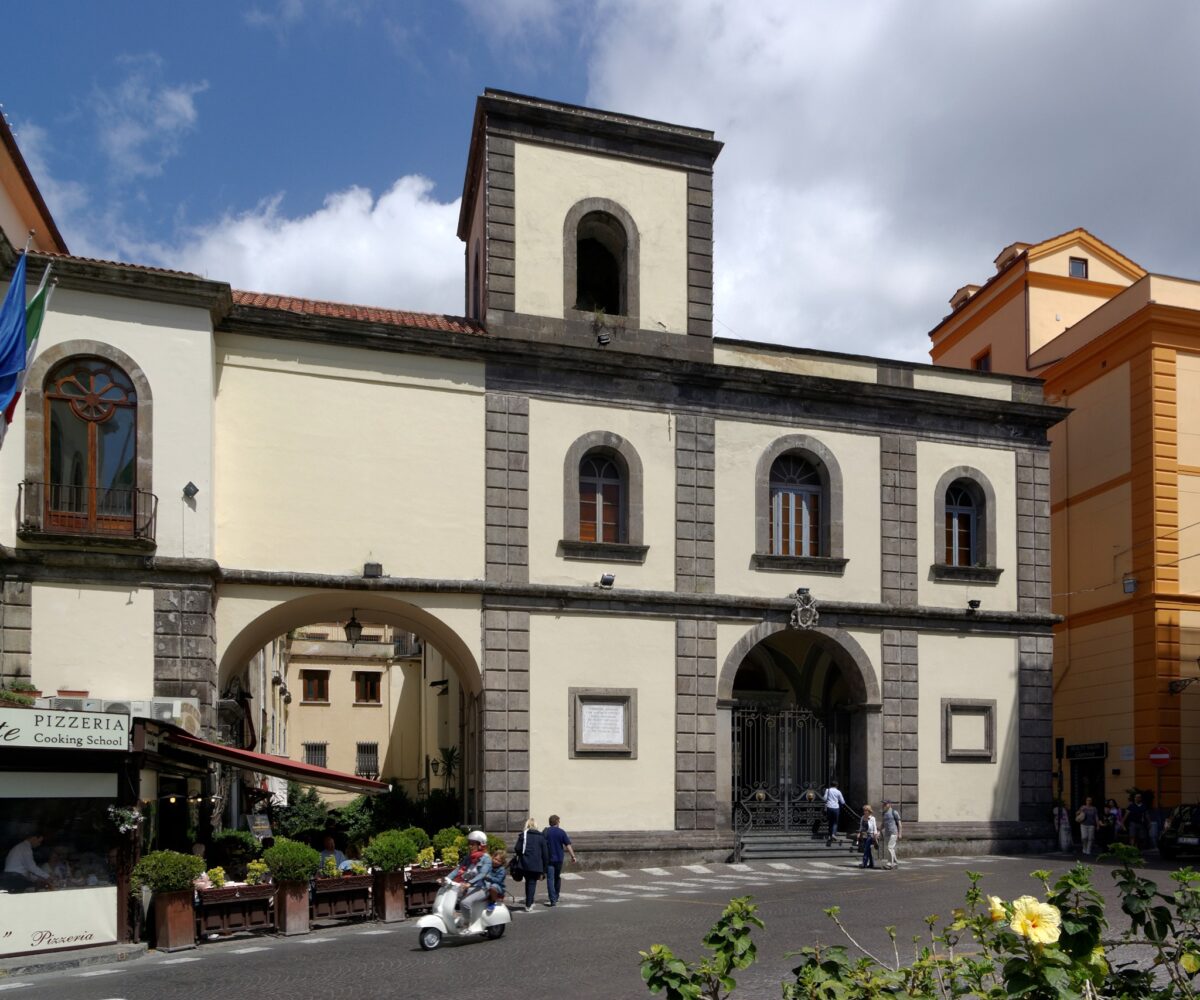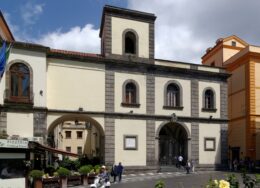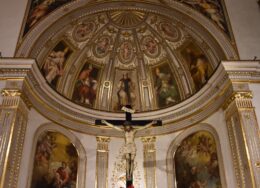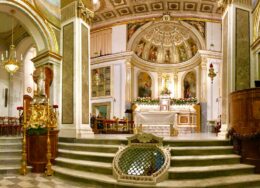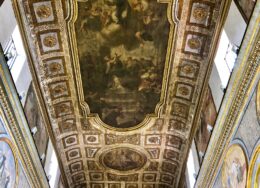Gallery
Description
HISTORY
The most popular church in Sorrento, the most precious and most linked to the history and devotion of the entire peninsula is the Basilica of Sant’Antonino Abate, Patron Saint of the City and of the Ancient Archdiocese. It was built near the old church of Sant’Agrippino, near which the Oratory of San Martino was built, built – according to tradition – by the saint himself.
Of the convent of Sant’Agrippino – of the Order of San Benedetto – Antonino was elected Abbot after the death of Dom. Boniface and there he died, in the year 625, being Probiano Consul of Sorrento, Emperor Heraclius and Supreme Pontiff Honorius (cf. A Cuomo, Sant’Antonino e i Quattro Vescovi Santi, Fidapa, 1991, pp. 10-11).
The age of its erection cannot be precisely determined, even if an Oratory was erected on the tomb of the Saint, a few years after his death, and then enlarged. Doyeva exist in the year 835, when Prince Sicardo of Benevento sent his daughter possessed by the devil, to be freed from the Saint (as the stories tell it happened), and was forced to lift the siege of Sorrento (cf. P. Ferraiuolo , Churches and monasteries of Sorrento, Congr. Servi di Maria, 1974, p. 47). And it is certainly from that date that the piety of the faithful made the temple dedicated to Abbot Antonino ever more beautiful and in 1380 a Confraternity of swingers was founded there who gathered in the succorpo.
In the Lucubrationes of Mons. Anastasio we find the confirmation of the existence of the church and from the Anonymous Sorrentino (the oldest writer of the Saint, published in 1626 by the Theatine Antonio Caracciolo) it is added that it was officiated by an Archpriest.
In a deed dated 10 September 1452 – reported in the Platea – it is found that the King himself appointed the Major Chaplain Domenico Exarch as Rector of the Church of Sant’Antonino, “vacata in manibus Domini Regis”. With a decree dated December 12, 1924, Pius XI elevated the church to a Pontifical Basilica, equating it to the minor Roman ones in terms of privileges.
THE OUTSIDE
The Romanesque facade, in gray tuff, has the bell tower inserted, elegant in its austerity and, with four gray marble steps, it gives access to a small porch, where on the right, above the urn that collects the remains of one of its rectors who ruled its fate for over fifty years, Moils. D. Francesco Gargiulo, the bones of the cetacean to which the miracle of Sant’Antonino is attributed, to which the Sorrentini are most closely linked are deposited. Above the access gate there is an arched aedicule with a beautiful fresco of the Saint (already taken over on the occasion of the Sacred Visit of the Archbishop Mons. Provenzale, in 1599).
On the opposite wall there is the marble testimony of the commitment of the “Sorrentini farmers” for the arrangement and embellishment of the same portico in 1886.
On the southern side of the basilica, on the ancient road named after the same saint – almost in the center – there is the small door, attributed to the century. X (see Album of the III Centenary of Tassiano). It is made largely with architectural and sculptural materials from the classical era: ancient yellow columns and Corinthian order capitals with a frame, part of another more complex frame.
THE CENTRAL NAVE
The central nave of the Basilica has six arches, supported by six columns on one side of various granite and on the other of remnants of pagan times: the first (towards the entrance) are leaning against the surrounding walls, the last (towards the cross) face solid marble pillars.
In the ovals – horizontal and five on each side – obtained between the rooms of the arches there are frescoes, above which the cornice develops with large windows, in whose filled spaces there are three other rectangular frescoes (larger than those in the ovals). : consequently it is possible to admire as many as 16 episodes from the life of Abbot Antonino and his miracles.
Proceeding from the entrance towards the altar, on the right side, we find – in the ovals – the Saint who saves a mason who has fallen from the bell tower (in the first), the apparition to the sculptor who had to make his statue and pays him the fee still owed to him (in the second), the liberation of a possessed woman from the devil (in the third), putting him to flight from the Saracen fleet (in the fourth) and the supply of fish to his devotees (in the last) and, above the cornice – in the rectangular paintings – the entry of Sant’Antonino into Sorrento amidst the welcome by Abbot Bonifacio and the Sorrentines, the appearance to the Pope who was keeping San Catello, bishop of Stabiae, in prison for unjust accusations, and the vision of the lit press on the top of the mountain. On the opposite – left – side below the ledge, the Saint who works the liberation of a possessed woman (in the first), the salvation of a ship in full storm (in the second), the healing of a deacon bitten by a snake ( in the third), the salvation of a goat who fell into a limestone (in the fourth) and the liberation of some workers from a falling boulder (in the last) while the three paintings, above the cornice, present the liberation of the boy from “whale”, the prodigious outpouring of water from Monte Aureo and the apparition of the Archangel San Michele.
Speaking of the silver statue of the Saint (made by the Sorrentine goldsmith Giovanni di Rosania in 1494), it should be noted that it too was plundered on the occasion of the nefarious invasion of the Saracens, on the night of 13 June 1558 and melted down to make weapons . The Sorrentini, to demonstrate once again their devotion to the patron saint, decided to create a new silver statue and entrusted the task to a Neapolitan goldsmith, also paying him the sum collected as an advance and agreeing that on completion of the work they would due paid. Unfortunately the economic affairs in Sorrento were not going in the right direction so they delayed going to Naples, but the same Saint came to their aid, who went to the goldsmith, gave him the agreed balance in a bag and suggested to the craftsman to look closely at him to portray his likeness in the statue. Meanwhile, after some time, having managed to collect the amount due, the delegates of the Sorrento people, who went to Naples, were surprised to find the work finished and ready to be delivered, with the balance already paid. They understood the miracle and it was decided to add a bag to the statue (to indicate the miracle) and the goldsmith sculpted the date and his name: 2 February 1564, Scipio di Costantino.
The ceiling is made with strong squares and gold rosettes on a blue background with three canvases by Giambattista Lama, from 1734: in the center the episode of the liberation of the daughter of Prince Sicardo with the Saint who, from heaven, propitiates the event and the various courtiers who accompany the possessed woman; towards the presbytery a tondo represents San Gaetano Thiene, founder of the Theatines who owned the convent and church for many years, while the other tondo (towards the entrance) is occupied by the image of Sant’Andrea Avellino, a Theatine saint.
THE PRESBYTERY
Reaching the crossing, which is accessed via five white marble steps, you come across the high altar, rich and majestic, in the past belonging to the nearby church of the suppressed Benedictine monastery of the Holy Trinity, consecrated on July 1, 1814 by the Archbishop of Sorrento , Mons. Vincenzo Calà.
Behind the said altar there is a wooden choir, on whose curved wall – in the upper part of the apse – there are the Patron Saints of Sorrento: in the center Sant’Antonino with on the right San Bacco and Sant’Attanasio and on the left San Renato and San Valerio (all by Giacomo Del Po and dated 1685).
On the side walls, occupied almost entirely, you can admire two canvases (by the same author, depicting, one, the liberation of Sorrento from the siege of Grillo in 1648 and, the other, the liberation of the city from the plague in 1656)
On the two walls to the side of the altar there are two reliquaries, coming from the Cathedral of Sorrento, made in 1608 by the archbishop Mons. Provenzale: they were transferred to the church of the patron saint between 1659 and 1679, when Mons. Suardo was archbishop. The box to the right of the altar contains 17 relics including those of San Bacolo, bishop of Sorrento in the 6th century; in the one on the left there are 21 relics and, among them, there are those of San Placido, one of the two favorite disciples of San Benedetto.
On the ceiling of the cruise the Holy Spirit is painted in the center of a large sunburst, which replaced the ancient paintings of Sant ‘Antonino and San Gaetano in the last century.
THE SIDE Aisles
The central nave, which leads from the entrance to the main altar, is flanked by two lateral naves which also lead to the succorpo or crypt below the presbytery and which are each equipped with two altars: on the right there are those of San Giuseppe (formerly the Madonna del Rosario) and Sant’Andrea Avellino, to the left of the Immaculate and San Gaetano Thiene.
The altar dedicated to the Immaculate Conception deserves a special mention, because you can admire a statue of the statue, ordered by the Superior Don Vincenzo Belli to the sculptor Citarelli in 1848 (considered the most beautiful modern statue of the peninsula).
The testimony of the entrustment of the church to the Theatine Fathers – which took place with a public deed dated 21 July 1608 – as well as by the aforementioned two altars to the Founder Saint of the Order and to Sant’Andrea, is validated by the eight paintings on canvas (four on each side) representing the main episodes in the life of the two saints.
THE CRYPT
The most visited part of the Basilica, where the devotees of the patron saint Antoninus are most concentrated, is the hypogeum or crypt, commonly called the succorpo and which occupies the entire eastern part of the sacred building, at a lower level than the one with direct entrance from the homonymous square and having access from two marble staircases following the two aisles. The entire area is supported by eight columns of precious marble recovered from the ancient pagan temples of the area, on which the support arches develop: four smaller ones inside the balustrade, which circumscribes the area of the altar, and four larger ones on the outside.
You can admire six canvases by the Sorrento painter Carlo Amalfi (1707-1787) still depicting the patron saints of Sorrento: the four bishops San Renato, San Valerio, Sant’Attanasio and San Bacolo and the other Saints Gennaro of Naples and Nicola di Bari. The other walls of the succorpo are enriched by ex votos, which are the testimony of faith in the Saint and of the graces received, and by a conspicuous series of “paintings” reproducing prodigious marine rescues.
At the center of the crypt stands the altar, on which a statue of the saint is placed, behind which is the perennial oil lamp with a silver foil that visitors touch, reciting the prayer reported therein in memory of the famous miracle of Saint Antonino of healing of the Sorrentine Bishop.
It is said that at the time of the life of Sant’Antonino the bishop of Sorrento (probably Amando), riding a mule, was thrown from the saddle near the city gate and, falling, broke his leg. With others the Holy Abbot Antonino visited him, who reassured him of an invocation to the Madonna. In fact, during the night, the Bishop dreamed of the Saint who, taking oil from a cruet in the hand of the Blessed Virgin, anointed his broken leg. In the morning the prelate found himself healed. Hence the devotion of anointing one’s hands behind the altar of the saint and crossing oneself with faith was born.
In the extreme side corners (behind the altar of the Saint) there are two small altars: the one on the left presents the picture of greatest artistic value in the whole basilica, a fresco of the Madonna delle Grazie from the 14th century, coming from the city walls and therefore considered the oldest Sorrento testimony to the Mother of God; the one on the right with the famous Crucifix, in wood covered with a silver sheath, which is carried in procession or on the occasion of exceptional events or as penance in serious public calamities.
The first solemn procession of penance is recorded from 17 February 1703, on the occasion of the continuous earthquakes that occurred in Naples and in the Gulf. Four years later (February 12, 1707) a similar procession took place to repair the interdict to which the city had been subjected for years and which was lifted on the following May 25, as well as in May 171, as the miracle of San Gennaro did not occur in Naples, to avoid imminent misadventures, as was expected on similar occasions, the miraculous Crucifix was once again carried in procession. There have been many other occasions for such a procession, of which the last, in memory, are those on the occasion of the eruption of Vesuvius in 1984 and the year of the Conversion announced by John Paul II: on this occasion behind the Crucifix brought by Archbishop Mons. Zama paraded the four mayors of the cities from Sorrento to Meta.
The two marble balustrades along the access stairways to the crypt were sculpted in 1753, while the frescoes by the painter Pietro Anton Squilles from 1691 were covered in stucco in 1778.
This part of the basilica is full of testimonies of the miracles of the Saint (another small part is in the room at the entrance to the sacristy). There is a whole exhibition of paintings of miraculous interventions for the salvation of seafarers, of which Sant’Antonino has always been considered effective patron, while a series of showcases contain the silver votive offerings of prodigies satisfying the invocations of the faithful for healings in the body.
THE SACRISTY
Moving on to the sacristy (very large, developed in several rooms and equipped with two entrances) one encounters many precious testimonies of the antiquity of the temple and of the devotion of the faithful.
The six “sketches” of the ovals (1778), displayed in the succorpo, by the Sorrentine painter Carlo Amalfi; an oil panel with a Madonna with Child (among the things most admired by Vittorio Sgarbi, in one of his visits to the basilica); another Byzantine-style image of the Mother of God in the Rector’s room and other works in the dressing room, including a magnificent oil panel showing the Virgin Mary between the two patron saints of the Archdiocese, Sant’Antonino and San Catello, a work from 1539 by Luca de Maxo, and a wooden sculpture from the 1600s depicting the Madonna del Rosario and a large wooden crucifix.
The sacristy is a small museum: in fact, other masterpieces are added to the paintings of the basilica’s heritage, objects of more or less recent donations to the Saint, demonstrating the ever-living devotion and constant faith in his patronage. Thus, among other things, one can admire an eighteenth-century miniature nativity scene full of shepherds and animals, recently donated, and a plastic reconstruction of the miracle of the whale.
Text taken from the book “The basilica of Sant’Antonino in Sorrento” by Antonino Cuomo
Contacts of the Sanctuary
| Address: | Piazza Sant'Antonino, 2 – 80067 Sorrento (NA) |
| Website: | https://www.facebook.com/basilicasantantoninosorrento/ |
| Telephone: | 081 878 14 37 |
| Mail: | basilicasantantonino@libero.it |
Celebrations
| Weekdays: | hours xx:xx |
| Holidays: | hours xx:xx |
| Other appointments: | day x |
| Confessions: | day x from xx:xx to xx:xx |



